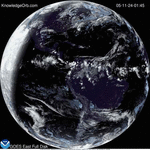
NASA’s Mars rover Curiosity used the Navigation Camera (Navcam) on its mast to record this westward look on the 347th Martian day, or sol, of the rover’s work on Mars (July 28, 2013).
Image Credit: NASA/JPL-Caltech
It is hard to believe it has been a year since we watched NASA Curiosity Rover land on Mars Aug. 6, 2012, EDT. This landing was more exciting than some of the previous missions due to the use of new technology. Landing with rocket motors and dangling from the sky crane the rover touched down on the surface of Mars perfectly. Since then the mission has gone almost perfectly. A testament to the fine engineers and technicians that built her. Thus far significant achievements include:
Over 190 Gigabits of data downloaded
75,000 laser shots on 2000 targets
70,000 pictures sent back to Earth
Over one mile driven.
“Successes of our Curiosity — that dramatic touchdown a year ago and the science findings since then — advance us toward further exploration, including sending humans to an asteroid and Mars,” said NASA Administrator Charles Bolden. “Wheel tracks now, will lead to boot prints later.”
JPL Video Twelve Months in Two Minutes on Mars.
Curiosity team members at NASA’s Jet Propulsion Laboratory in Pasadena, Calif.,will share remembrances about the dramatic landing night and the overall mission in an event that will air on NASA Television and the agency’s website from 7:45 to 9 a.m. PDT (10:45 a.m. to noon EDT) on Tuesday, Aug. 6.
Curiosity is currently on a five mile drive to the base of Mount Sharp, where it will investigate lower layers of a mountain that rises three miles from the floor of the crater.
Evidence of a past environment well suited to support microbial life came within the first eight months of the 23-month primary mission from analysis of the first sample material ever collected by drilling into a rock on Mars.
“We now know Mars offered favorable conditions for microbial life billions of years ago,” said the mission’s project scientist, John Grotzinger of the California Institute of Technology in Pasadena. “It has been gratifying to succeed, but that has also whetted our appetites to learn more. We hope those enticing layers at Mount Sharp will preserve a broad diversity of other environmental conditions that could have affected habitability.”
The mission measured natural radiation levels on the trip to Mars and is monitoring radiation and weather on the surface of Mars, which will be helpful for designing future human missions to the planet. The Curiosity mission also found evidence Mars lost most of its original atmosphere through processes that occurred at the top of the atmosphere. NASA’s next mission to Mars, Mars Atmosphere and Volatile Evolution (MAVEN), is being prepared for launch in November to study those processes in the upper atmosphere.
You can follow the conversation online about Curiosity’s first year on Mars, use hashtag #1YearOnMars or follow @NASA and @MarsCuriosity on Twitter.
For more information about the mission, visit http://www.nasa.gov/msl andhttp://mars.jpl.nasa.gov/msl .







